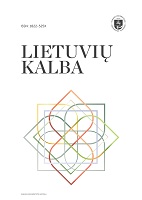THEY ARE KIND OF/SORT OF SIMILAR: A PARALLEL CORPUS-BASED ANALYSIS OF ENGLISH KIND OF AND SORT OF AND THEIR LITHUANIAN CORRESPONDENCES
THEY ARE KIND OF/SORT OF SIMILAR: A PARALLEL CORPUS-BASED ANALYSIS OF ENGLISH KIND OF AND SORT OF AND THEIR LITHUANIAN CORRESPONDENCES
Author(s): Audronė ŠolienėSubject(s): Language studies, Lexis, Comparative Linguistics, Baltic Languages
Published by: Vilniaus Universiteto Leidykla
Keywords: Lithuanian; English; nouns; "kind of"; "sort of"; corpus-based analysis;
Summary/Abstract: The present paper reports on the English type nouns kind of and sort of and their Lithuanian correspondences in a contrastive perspective. This paper aims to describe the quantitative and qualitative distribution of the English kind of andsort of, to determine their translational correspondences in Lithuanian as well as to reveal how Lithuanian correspondences correlate with the functions (textual and interpersonal) that kind of and sort of perform in original and translated fiction texts. The research method is a quantitative and qualitative contrastive analysis based on data extracted from the self-compiled bidirectional corpus ParaCorpEN→LT→EN comprising fiction texts. The results show that kind of and sort of are prone to be used NP-internally; however, even in this construction they can feature as DMs. Kind of and sort of function as unambiguous DMs when they completely lose their nominality, i.e. are used NP-externally. The functional and semantic potential of the type nouns is fully reflected by their TCs. Very rarelykind of and sort of denoting a type are translated congruently into a Lithuanian type noun; they usually correspond to demonstrative pronouns. As discourse markers, kind of and sort of are realised by different Lithuanian correspondences which may help establish the common ground between the speaker and the hearer or refer to the previous context, may indicate epistemic imprecision, approximation or downtone a proposition. The high number of zero correspondence shows that the Lithuanian type nouns have not advanced on the grammaticalization path the way the English type nouns have and due to the multifunctionalilty, non-propositionality and context-dependence there is no one-to-one correspondence of the markers under scrutiny.
Journal: Lietuvių kalba
- Issue Year: 2020
- Issue No: 14
- Page Range: 1-32
- Page Count: 32
- Language: English

